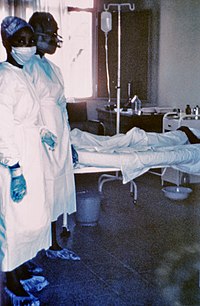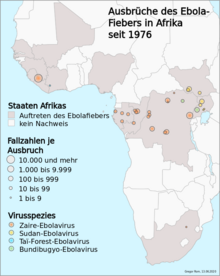Zaire Ebola Virus
| Zaire Ebola Virus | ||||||||||||||||||||
|---|---|---|---|---|---|---|---|---|---|---|---|---|---|---|---|---|---|---|---|---|

This 1976 photo shows two nurses standing in front of Ebola case number 3, which was treated and later died at Ngaliema Hospital in Kinshasa, Zaire. |
||||||||||||||||||||
| Systematics | ||||||||||||||||||||
|
||||||||||||||||||||
| Taxonomic characteristics | ||||||||||||||||||||
|
||||||||||||||||||||
| Scientific name | ||||||||||||||||||||
| Zaire ebolavirus | ||||||||||||||||||||
| Short name | ||||||||||||||||||||
| ZEBOV | ||||||||||||||||||||
| Left | ||||||||||||||||||||
|
The Zaire Ebolavirus ( scientifically Zaire ebolavirus , ZEBOV ) is a virus species from the genus Ebolavirus . It was isolated as the first member of the genus in 1976 in an outbreak in Zaire as the causative agent of severe hemorrhagic fever . Although there are morphological and clinical similarities to the already known Marburg virus (MARV), the characterization showed no serological cross-reactivity between the new isolates and the Marburg virus , so that the newly isolated virus was assigned to a new species . This has been by later data of the virus genome in terms of RNA - sequence and the arrangement and functionality of the genes confirmed.
The species and genus name is derived from the name of the Ebola river , which is located near the epidemic area at that time . Compared to other Ebola viruses, the Zaire Ebola virus together with the Sudan Ebola virus (SUDV) shows the highest mortality rate of around 50–90% in the clinical course . It is assigned to the highest risk group 4 by the Biological Agents Ordinance in conjunction with the TRBA ( Technical Rules for Biological Agents) 462 . In addition, as an Ebola virus , it is one of the pathogens that must be reported under the Infection Protection Act ( Section 7 IfSG).
Occurrences and ZEBOV outbreaks
Since its discovery as the virus responsible for the 1976 epidemic in Zaire (now DR Congo ), the Zaire Ebola virus has been identified in various outbreaks in Central African countries. For example, in several outbreaks in the DR Congo ( Tandala 1977, Kikwit 1995, Mbomo 2002 and 2003, Luebo 2007 and 2008), in Gabon ( Mekouka 1994, Mayibout 1996, Booue 1996, Libreville 2001) and Uganda ( Gulu 2000). In South Sudan ( Yambio 2004) and South Africa ( Johannesburg 1996) it was very likely that the infection was imported with only a small number of cases. The Sudan Ebola virus can otherwise be found in outbreaks in South Sudan . According to the current state of knowledge, the Ebola fever epidemic from 2014 to 2016 in West Africa was also a ZEBOV strain of Central African origin. In the Ebola fever epidemic 2018-2020 in eastern Congo also ZEBOV is described as the cause.
Due to the distribution pattern of the outbreaks in the human population and the detection of Ebola virus-specific antibodies in wild animals (especially fruit bats ), an original endemic occurrence of ZEBOV in the Central African countries mentioned, and here primarily in the forest areas, can be assumed.
Systematics
The isolates in the epidemics identified so far show clear sequence differences at the level of the genome and the virus proteins . These were therefore differentiated as separate subtypes within the species . The differences between the subtypes are, for example, up to 42% at the nucleotide level in the GP gene.
- Genus Ebola virus
- Species Zaire Ebola Virus
- Subtype Zaire Ebolavirus Mayinga (ZEBOV-May)
- Subtype Zaire Ebolavirus Eckron (ZEBOV-Eck)
- Subtype Zaire Ebolavirus Gabon (ZEBOV-Gab)
- Subtype Zaire Ebolavirus Zaire (ZEBOV-Zai)
- Subtype Zaire Ebola Virus Kikwit (ZEBOV-Kik)
- Subtype Zaire Ebolavirus Tandala (ZEBOV-Tan)
literature
- Ebola haemorrhagic fever in Zaire, 1976. In: Bulletin World Health Organization. (1978) 56; 2: pp. 271-293 PMID 307456 ( PMC 2395567 (free full text))
- KS Brown, A. Silaghi, H. Feldmann: Ebolavirus . In: Allan Granoff, Robert G. Webster (eds.): Encyclopedia of Virology . San Diego, 1999, Volume 2, pp. 57-65 ISBN 0-12-227030-4
- H. Feldmann et al .: Genus Ebolavirus. In: CM Fauquet, MA Mayo et al .: Eighth Report of the International Committee on Taxonomy of Viruses. London, San Diego, 2005 ISBN 0-12-249951-4 pp. 651-653
Individual evidence
- ↑ ICTV Master Species List 2018b.v2 . MSL # 34, March 2019
- ↑ a b ICTV: ICTV Taxonomy history: Akabane orthobunyavirus , EC 51, Berlin, Germany, July 2019; Email ratification March 2020 (MSL # 35)
- ↑ KM Johnson, JV Lange, PA Webb, FA Murphy: Isolation and partial characterization of a new virus causing acute haemorrhagic fever in Zaire . Lancet (1977) 1; 8011: pp. 569-571 PMID 65661
- ^ ET Bowen et al. : Viral haemorrhagic fever in southern Sudan and northern Zaire. Preliminary studies on the aetiological agent. Lancet (1977) 1; 8011: pp. 571-573 PMID 65662
- ↑ TRBA (Technical Rules for Biological Agents) 462: Classification of viruses in risk groups by the Federal Institute for Occupational Safety and Health (BAuA) . April 25, 2012, pp. 4, 27, accessed August 9, 2014
- ^ S. Pattyn, G. vander Groen, W. Jacob, P. Piot and G. Courteille: Isolation of Marburg-Like Virus from a Case of Hæmorrhagic Fever in Zaire. In: The Lancet . Volume 309, No. 8011, 1977, pp. 573-574, doi: 10.1016 / S0140-6736 (77) 92002-5
